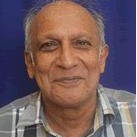
Anthony J. Rodrigues
Work place: School of Informatics & Innovative Systems, Jaramogi Oginga Odinga University of Science & Technology - Kenya
E-mail: tonyr@jooust.ac.ke
Website:
Research Interests: Solid Modeling, Information Theory, Algorithmic Information Theory, Theory of Computation, Models of Computation
Biography
Prof. Anthony Joachim Rodriguez is a Kenyan computer scientist and educator. He holds a Bachelor of Science in electrical engineering (University of Manchester, England), Master of Science in control systems (University of Manchester, institute of science & technology, England) and Doctor of philosophy in science computation (University of Manchester, institute of science & technology, England). He has lectured in a number of universities and is currently a director, directorate of information and communications technology of Jaramogi Oginga Odinga university of science and technology. His research interests include scientific computation, approximation theory, modeling, informatics policy among others.
Author Articles
Tracking Area Boundary-aware Protocol for Pseudo Stochastic Mobility Prediction in LTE Networks
By Vincent Omollo Nyangaresi Silvance O. Abeka Anthony J. Rodrigues
DOI: https://doi.org/10.5815/ijitcs.2020.05.04, Pub. Date: 8 Oct. 2020
Accurate mobility prediction enables efficient and faster paging services in these networks. This in turn facilitates the attainment of higher bandwidths and execution of activities such as handovers at low latencies. The conventional mobility prediction models operate on unrealistic assumptions that make them unsuitable for cellular network mobile station tracking. For instance, the Feynman-Verlet, first order kinetic model and Random Waypoint assume that mobile phones move with constant velocity while Manhattan, Freeway, city area, street unit, obstacle mobility, and pathway mobility postulate that mobile station movement is restricted along certain paths. In addition, obstacle mobility model speculate that the mobile station signal is completely absorbed by an obstacle while random walk, random waypoint, Markovian random walk, random direction, shortest path model, normal walk, and smooth random assume that a mobile station can move in any direction. Moreover, the greatest challenge of the random direction model is the requirement that a border behavior model be specified for the reaction of mobile stations reaching the simulation area boundary. In this paper, a protocol that addresses the border behavior problem is developed. This protocol is shown to detect when the subscriber has moved out of the current tracking area, which is crucial during handovers.
[...] Read more.Other Articles
Subscribe to receive issue release notifications and newsletters from MECS Press journals